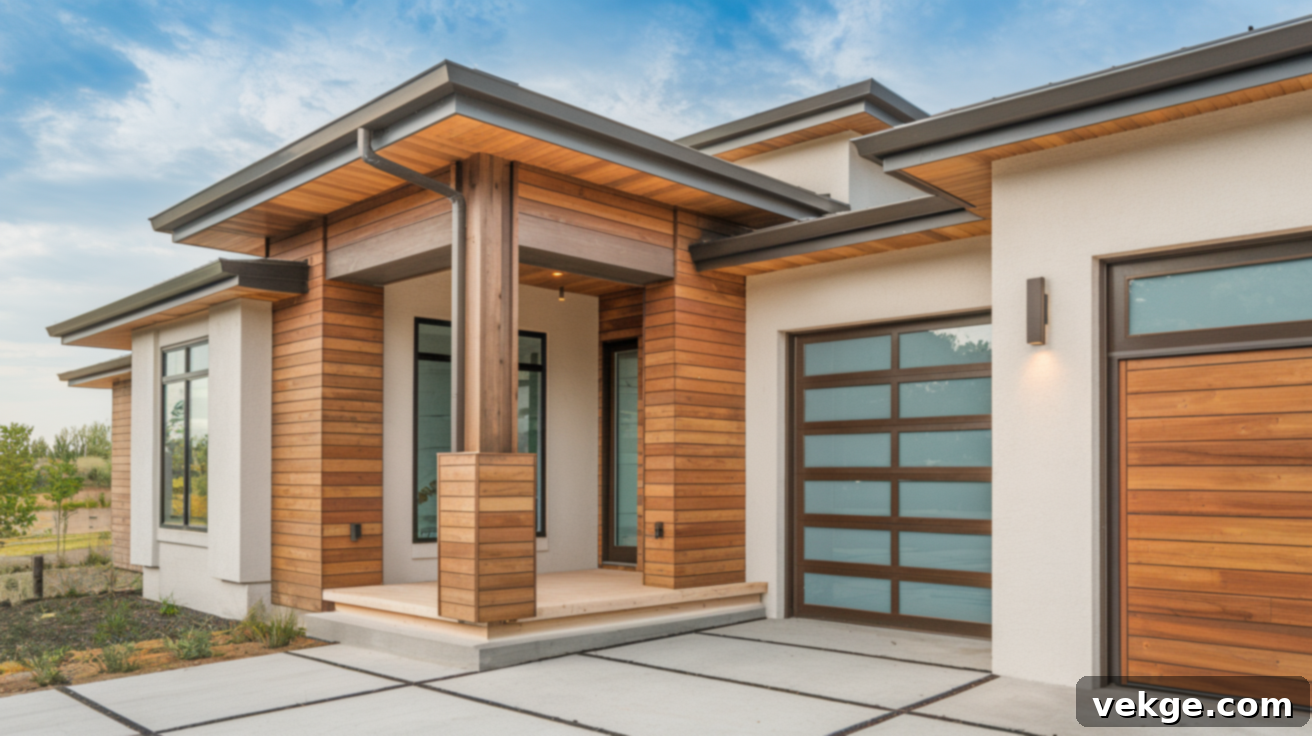Elevate Your Home’s Curb Appeal: The Ultimate Guide to Wood Accent Siding for Exteriors
Do you ever feel like your home blends in with every other house on the street? You’re certainly not alone. Many homeowners are seeking effective ways to infuse their property’s exterior with unique warmth, rich color, and distinctive character. If you’re looking to transform your home from ordinary to extraordinary, wood accent siding offers a powerful and elegant solution.
Adding natural wood elements or high-quality wood-look accents is a timeless approach to introducing organic textures and inviting tones to your home’s facade. It instantly creates a more welcoming and personalized aesthetic, setting your property apart and significantly boosting its curb appeal. This comprehensive guide will walk you through everything you need to know about incorporating wood accent siding into your home’s exterior design.
We’ll explore the most impactful locations to add wood siding, delve into the various material options available (including high-performance alternatives), and provide practical advice on making smart choices that align with your budget, local climate, and personal style. Get ready to discover inspiring ideas and gain the confidence to embark on your next home improvement project with a clear vision.
Why Homeowners Are Choosing Wood Accent Siding for Their Exteriors
Wood accent siding is far more than just a decorative element; it’s a strategic design choice that offers a multitude of benefits for homeowners. Beyond simply breaking up monotonous wall surfaces, these natural touches introduce a rich, tactile dimension and create dynamic visual contrast, transforming a house into a warm, inviting home.
- Boosts Curb Appeal and Property Value: One of the most significant advantages of incorporating wood accents is their immediate positive impact on your home’s curb appeal. A well-designed exterior with natural wood elements can make a powerful first impression, signaling quality and thoughtful design. This enhanced aesthetic can directly translate into increased property value, making it a smart investment for any homeowner considering an exterior renovation.
- Unmatched Design Flexibility: Wood accent siding offers incredible versatility, allowing it to seamlessly integrate with various architectural styles and existing materials. Whether your home features modern fiber cement, sleek metal panels, classic brick, or textured stucco, wood accents can be paired to create a cohesive yet dynamic look. This flexibility enables homeowners to achieve a truly customized exterior design that reflects their personal taste and complements their home’s architecture.
- Adds Warmth, Texture, and Balance: The inherent beauty of wood brings an organic warmth that synthetic materials often struggle to replicate. Its natural grain and varied tones introduce visual texture that adds depth and interest to flat facades. Even small, strategically placed touches – such as a wooden trim around windows or a soffit lining – can profoundly affect the home’s overall balance and inviting atmosphere, making it feel more grounded and harmonious.
- Personalization and Character: In a world of often-uniform housing, wood accents provide an invaluable opportunity for personalization. They allow homeowners to inject unique character and a touch of nature into their modern, traditional, or even contemporary dwellings, moving away from cookie-cutter designs and creating a truly bespoke exterior.
Strategic Locations to Incorporate Wood Accent Siding
You don’t need to embark on a full-scale exterior overhaul to make a significant impact with wood accents. Often, the most effective use of these natural elements comes from strategically placing them in key areas that draw the eye and enhance specific features of your home. Here are some of the most popular and impactful spots to add wood accent siding:
1. Entryways and Front Door Surrounds
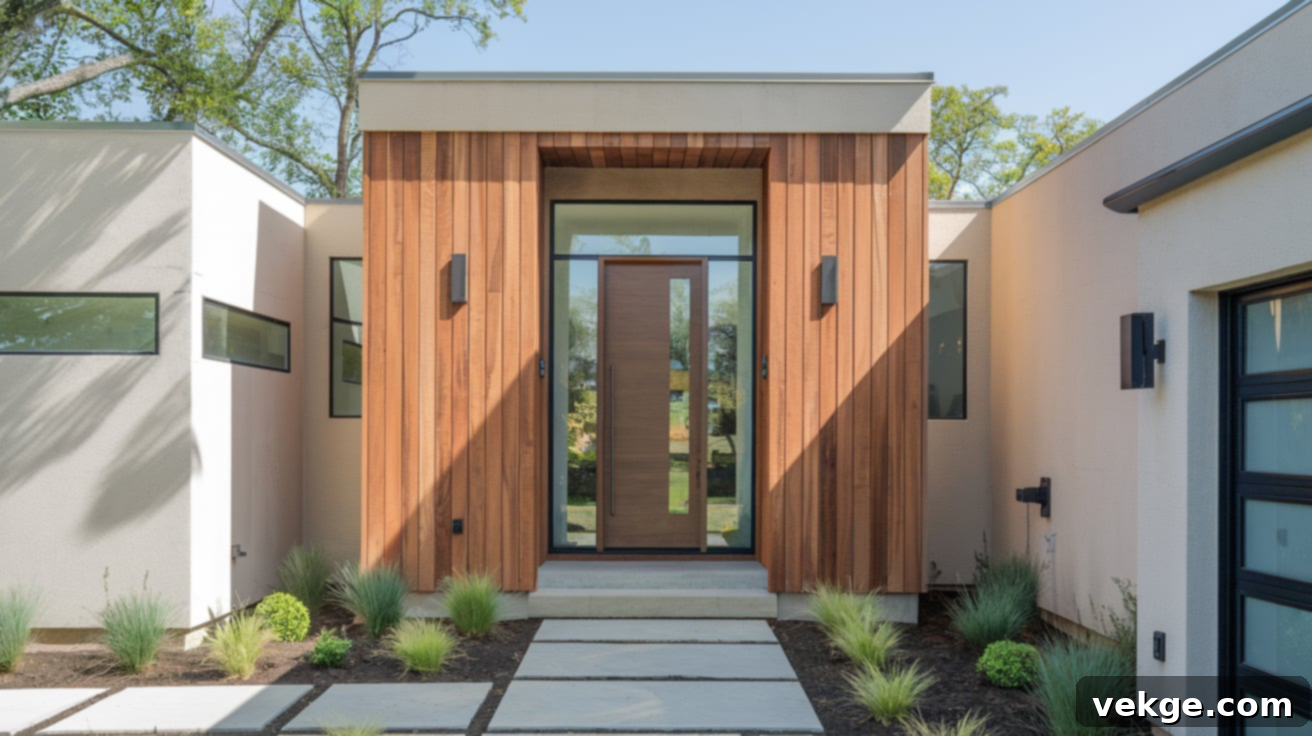
The entryway is the focal point of your home’s facade and often the first area visitors experience. Incorporating wood accent siding around your front door or on an adjacent entry wall instantly creates a profoundly inviting and warm welcome. This strategic placement naturally draws the eye, highlighting the entrance and setting a comfortable, personalized tone for anyone approaching your home.
The beauty of using wood in entryways is that you don’t need an extensive renovation to achieve a significant impact. Even a modest wooden feature, such as vertical wood planks flanking the door, a wooden soffit above the porch, or a horizontal wood panel accenting the main entry wall, can infuse the space with organic warmth and make your home feel more distinctly yours. A thoughtful update here not only enhances aesthetic appeal but also leaves a lasting positive impression, making your home feel more welcoming.
2. Garage Doors and Surrounds
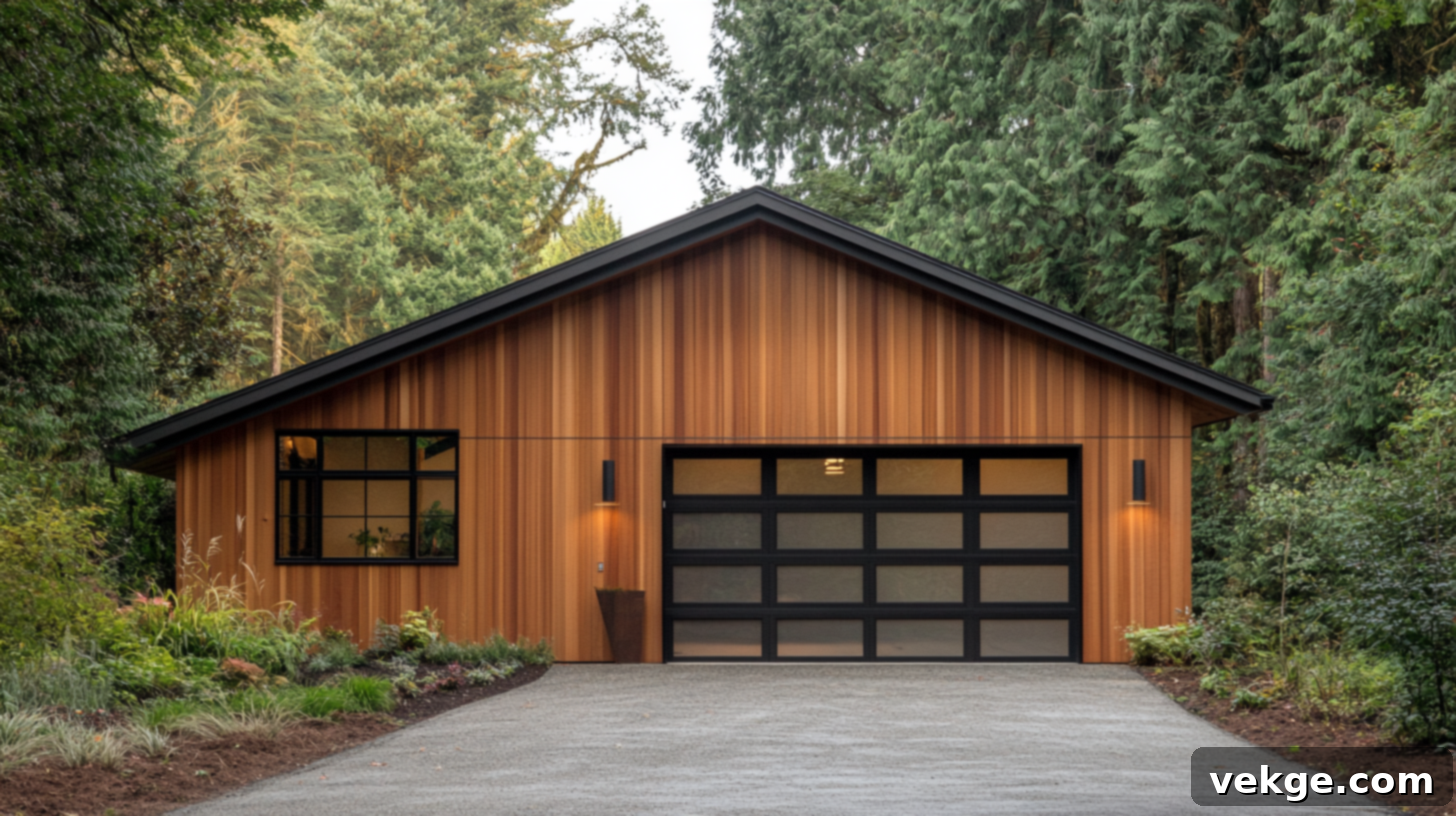
Garage doors often consume a substantial portion of a home’s front facade, especially on modern or suburban homes. Framing the garage with wood planks – whether oriented vertically to add height or horizontally for a classic feel – can effectively break up large, plain siding surfaces. This instantly adds visual interest and makes the entire front elevation feel more balanced and intentionally designed.
This approach allows you to introduce sophisticated detail without the need to replace the entire exterior. You can either match the tone of the wood accents to your garage door itself for a seamless look or choose a contrasting wood finish to create a more dynamic and eye-catching feature. It’s a particularly smart way to give the garage its own refined style, ensuring it complements rather than overwhelms the rest of your home’s exterior, especially if it faces the street.
3. Porch Columns and Posts
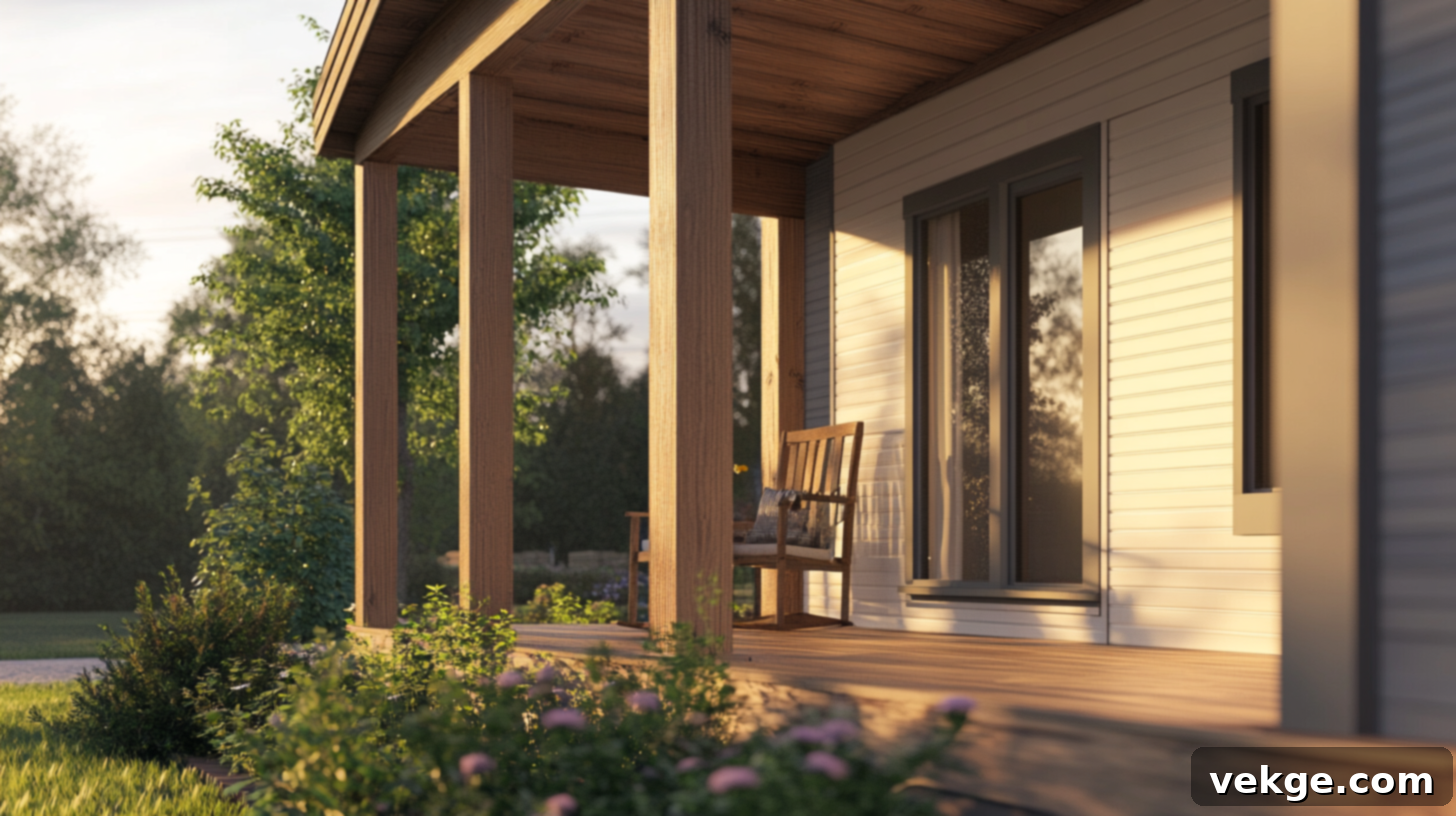
For homes with porches or covered entryways, wrapping existing support posts or columns in wood siding adds an immediate sense of permanence and a grounded, natural feel. This is a relatively simple upgrade that significantly elevates your outdoor living space, giving it more charm, architectural structure, and a welcoming presence without the need for a complete exterior makeover.
Wood columns pair beautifully with a wide range of siding materials, including sleek metal, durable fiber cement, or traditional vinyl, making them an adaptable choice for blending with your home’s current aesthetic. This small yet impactful change can breathe new life into an older porch, providing an inviting focal point, or help a new build feel more finished and establish a stronger connection to its natural surroundings. Consider using reclaimed wood for an even more unique and eco-friendly touch.
4. Soffits and Overhangs
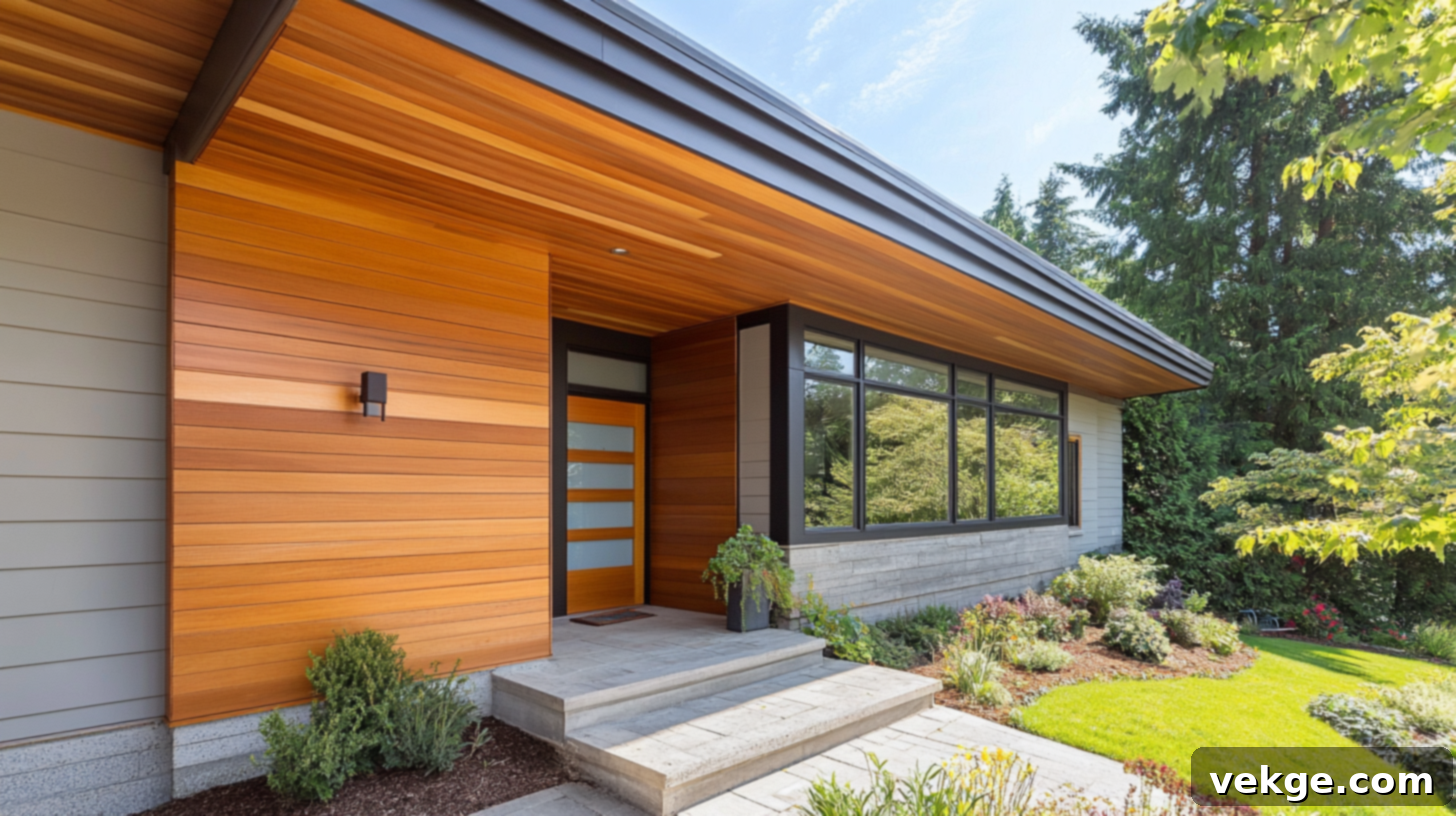
Often overlooked, the soffits (the underside of your roof’s overhang) and other exterior overhangs present a fantastic opportunity to introduce wood accents for a softer, more refined finish. These subtle areas, when clad in natural wood tones, create a warm contrast to typical siding materials, adding an unexpected layer of detail and sophistication to your home’s exterior.
A significant advantage of applying wood in these specific locations is that they are naturally tucked under the roofline, providing excellent protection from direct exposure to harsh weather elements like heavy rain and intense sunlight. This inherent shielding means the wood experiences less wear and tear over time, leading to lower maintenance requirements and greater longevity. It’s a clever, low-upkeep way to infuse your home with natural beauty and architectural depth.
5. Full Walls or Partial Sections
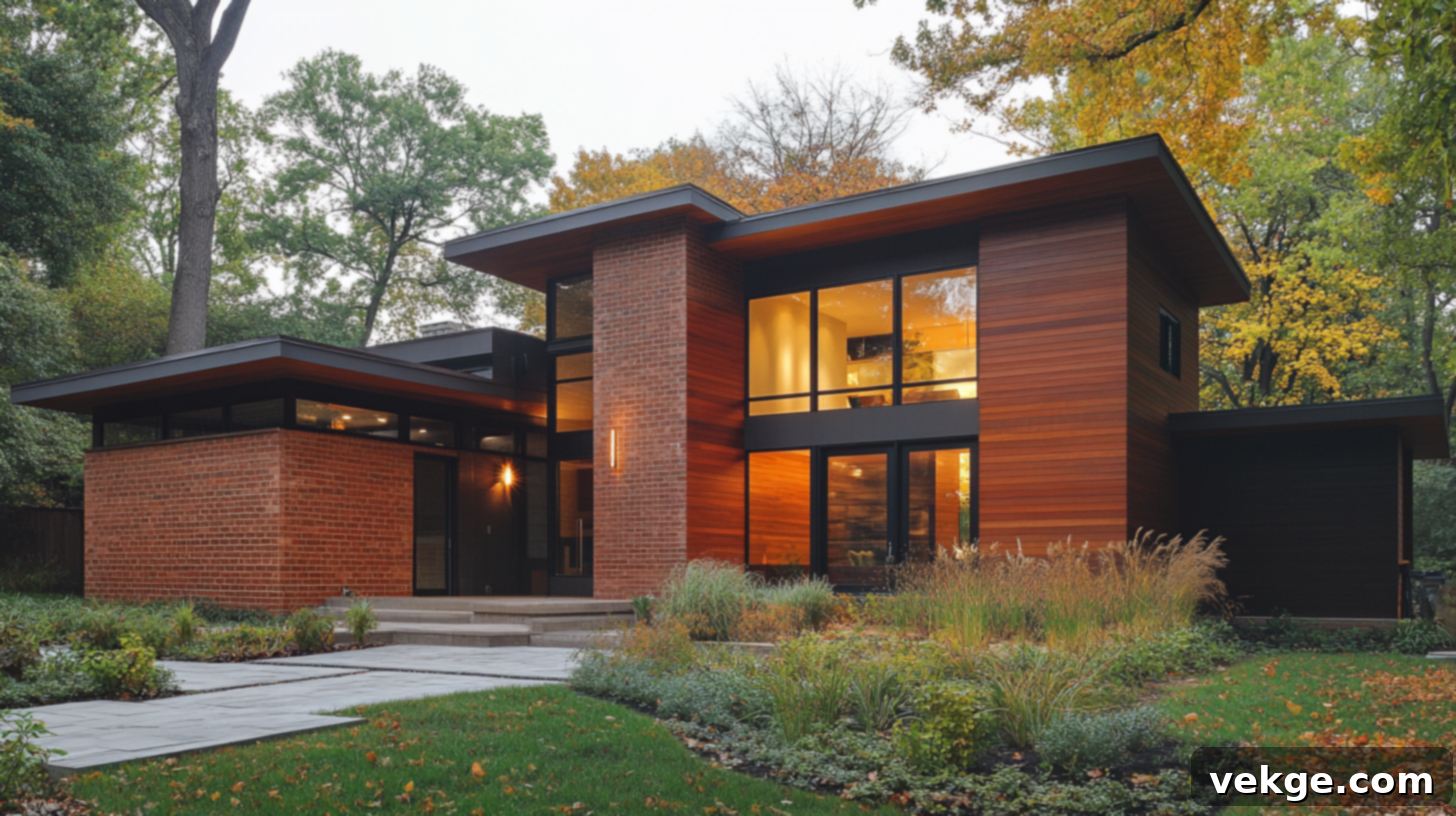
For homeowners looking to make a bolder statement, using wood accent siding on an entire section of your home – such as a prominent side wall, a projecting architectural feature, or around a bay window – can create an incredibly distinctive and elegant focal point. This approach allows a specific area to stand out beautifully, providing visual separation and texture.
Applying wood siding to a single section helps to break up long, flat surfaces, adding architectural interest without overwhelming the overall design. You can seamlessly mix wood with other materials like fiber cement panels, classic brick, or sleek metal siding for a rich, multi-textured facade. This option offers immense creative freedom, allowing you to highlight unique architectural elements while maintaining a clean, sophisticated, and cohesive exterior design.
Inspiring Wood Accent Siding Design Ideas
Beyond choosing where to place your wood accents, how you arrange and combine them plays a crucial role in defining your home’s style. There’s more than one way to integrate natural wood into your home’s exterior, from subtle updates to dramatic features. These design ideas are crafted to help you find a style that perfectly fits your space, your budget, and your aesthetic preferences.
Let’s explore some easy-to-understand ways to utilize wood accent siding that blend harmoniously with various siding types and architectural layouts, ensuring a stunning and personalized finish.
1. Horizontal + Vertical Plank Mix
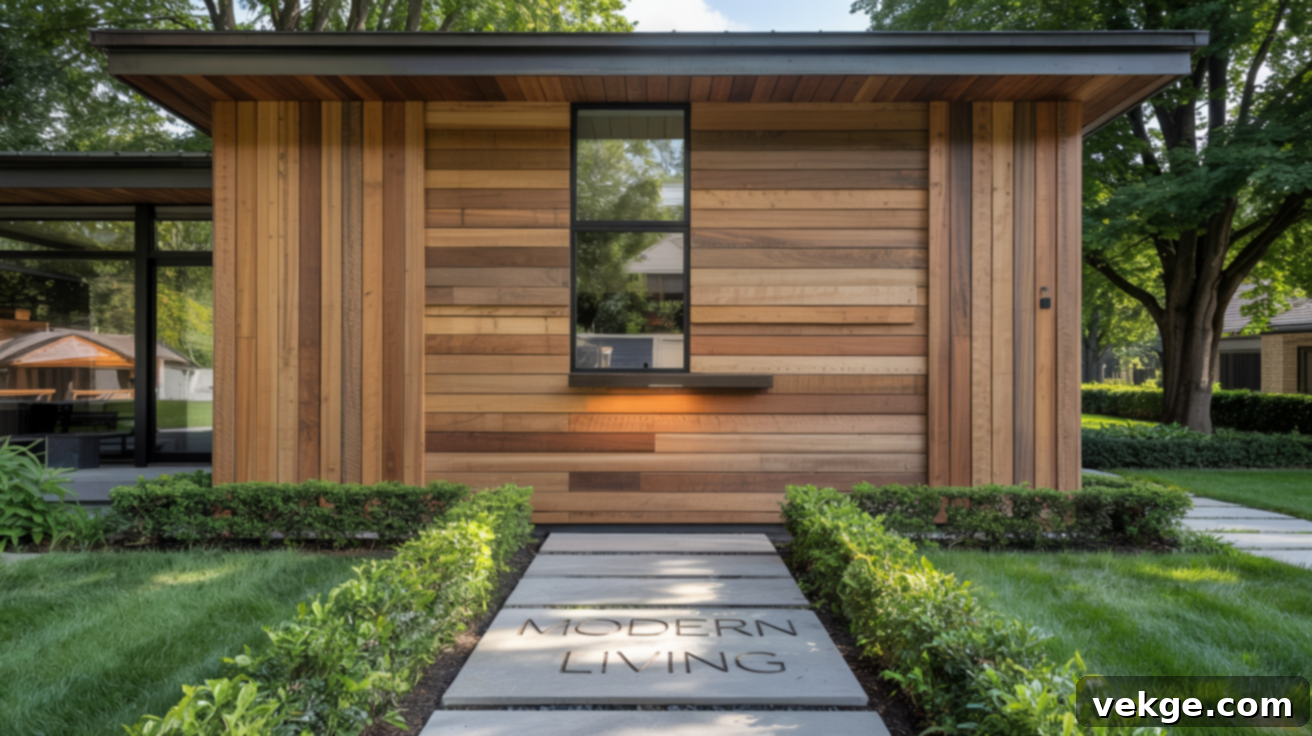
Mixing the orientation of your wood planks is a dynamic and effective way to break up large, monotonous wall surfaces and add significant visual interest. Horizontal boards offer a timeless, classic look that can make a home feel wider and more grounded, while vertical planks draw the eye upward, creating a sense of height and contemporary elegance.
When used together, perhaps on different sections of a single facade or to delineate distinct architectural zones, this combination adds depth and sophistication without appearing overly busy. This design strategy works exceptionally well on both small accent areas and larger sections of the house, allowing you to play with proportions and create a truly custom exterior that catches the eye from every angle.
2. Wood Trim Accents Only
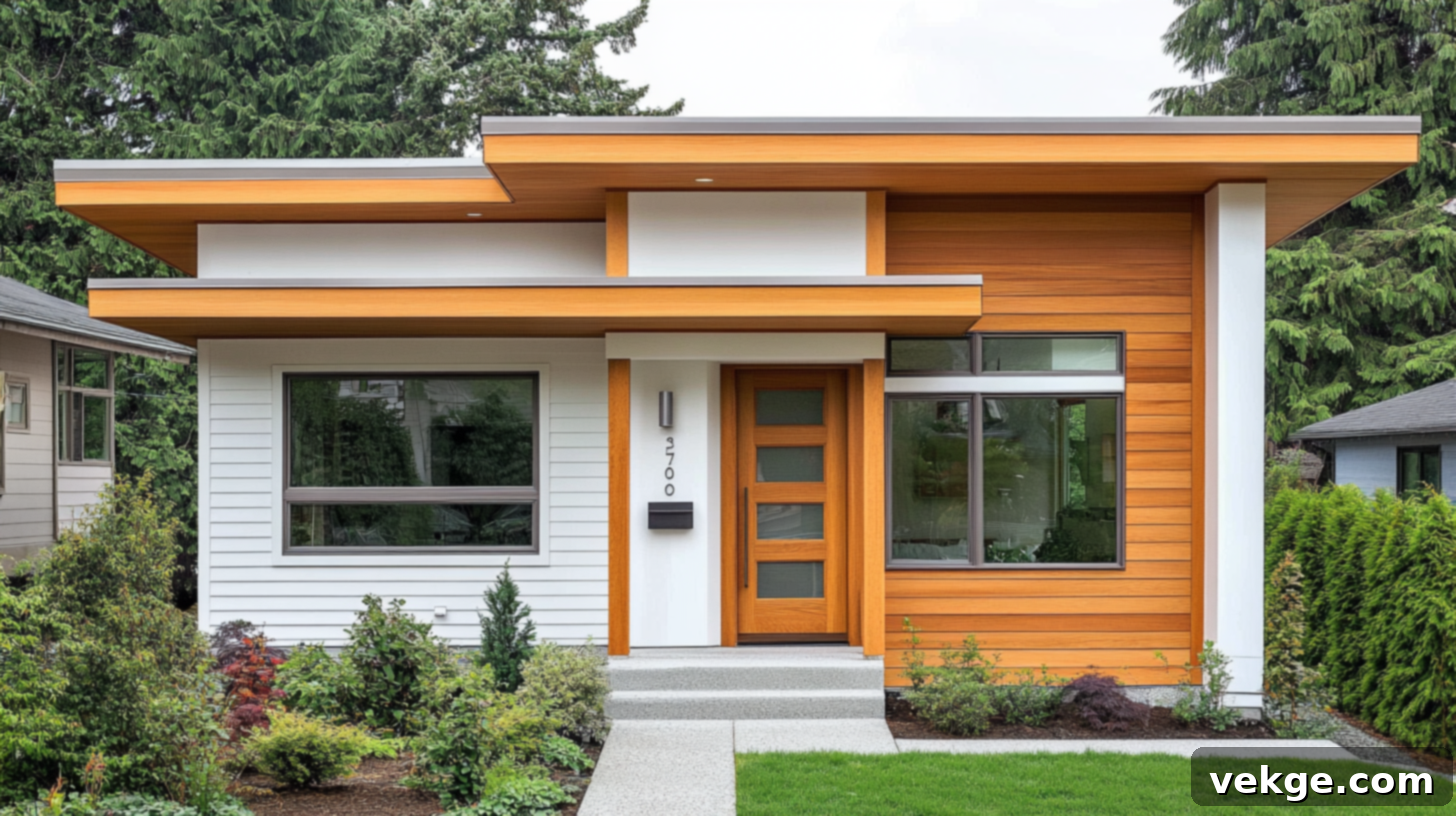
You don’t always need extensive siding changes to make a significant impact. Simply adding wood trim around doors, windows, or as corner boards offers a quick, elegant refresh to your home’s exterior. This subtle yet powerful design choice defines architectural features and provides a striking visual contrast against existing siding materials, adding a touch of natural warmth.
Opting for wood trim is often one of the more budget-friendly and less labor-intensive options for introducing natural elements. It’s a smart and low-commitment choice if you’re looking to experiment with wood accents, add a rustic or craftsman touch, or simply enhance the architectural details of your home without undertaking a full exterior renovation. It proves that even small details can yield impressive aesthetic returns.
3. All-Wood Entryways
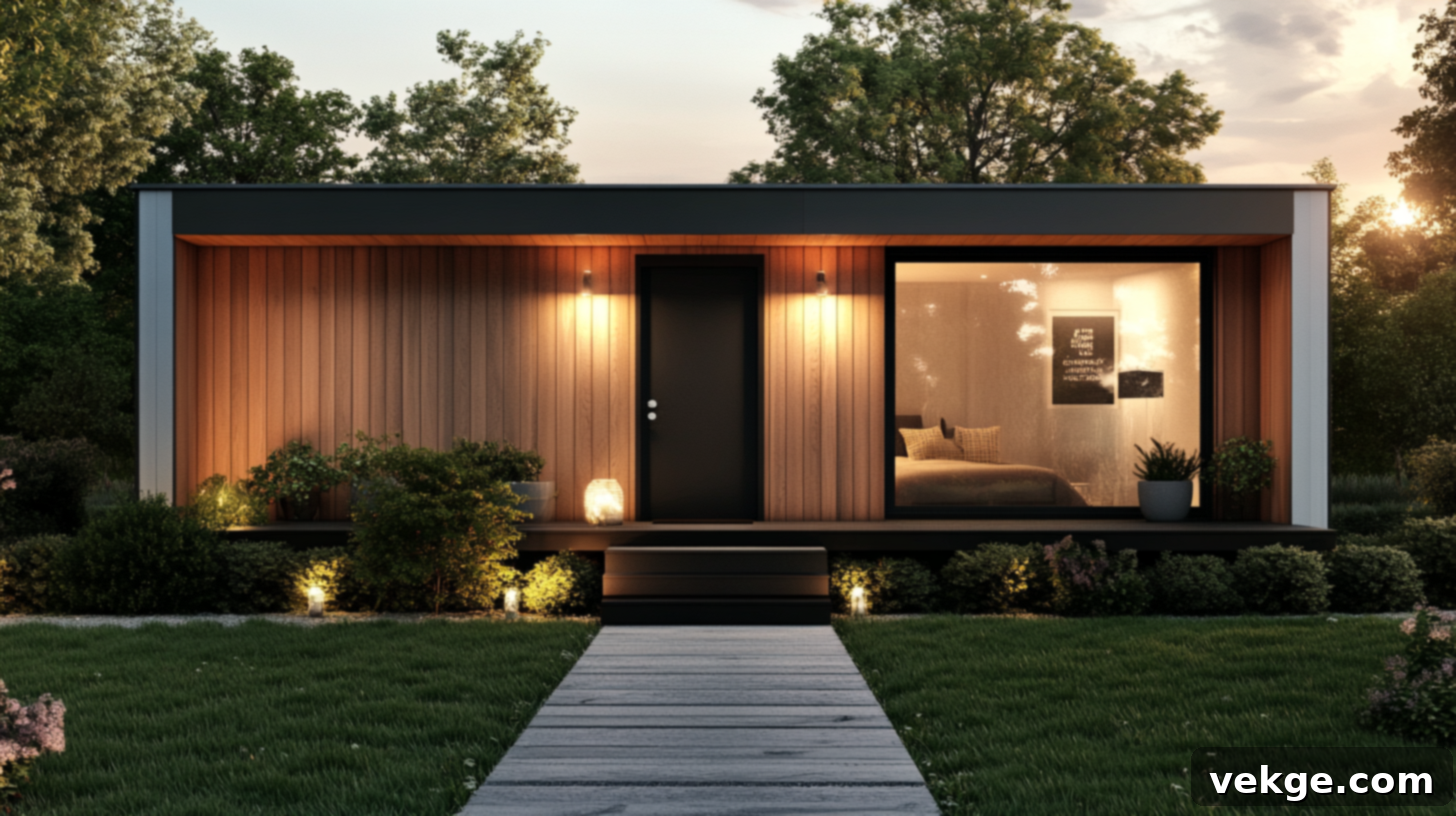
Creating an entire front wall or a dedicated entry vestibule clad completely in wood makes a profound statement and offers an exceptionally warm and inviting welcome. This design approach strategically highlights the main entrance, transforming it into a prominent architectural feature and immediately making the space feel more personal and grounded.
This all-wood entryway concept works beautifully in conjunction with surrounding siding in crisp black, clean white, or sophisticated gray tones, providing a stunning contrast. The natural wood inherently softens any sharp edges or stark lines from adjacent materials, imparting a friendly, approachable, and highly custom touch to your home’s exterior. It’s an excellent way to merge modern design sensibilities with timeless natural warmth.
4. Mixed-Material Facades

Blending wood accent siding with other exterior materials—such as classic white planks, sleek black panels, durable stucco, or traditional brick—adds incredible depth and visual variety to your home’s facade. Each material contributes a unique texture, color, and character, and the wood acts as a unifying element, tying all these diverse components together into a cohesive and visually rich design.
This kind of mixed-material approach creates a contemporary, custom look that stands out. To maintain a clean and sophisticated aesthetic, it’s generally best to stick to a palette of two or three primary finishes. This ensures that the design remains intentional and harmonious, preventing the exterior from appearing cluttered or haphazard. Thoughtful material selection and placement are key to a successful mixed-material facade that truly elevates your home.
Top Materials for Wood Accents on House Exterior
When considering wood accents for your home’s exterior, it’s important to understand that “wood siding” doesn’t always mean real timber. Many homeowners are increasingly choosing high-performance lookalike products, not only for their superior durability and lower upkeep but also for their consistent appearance and environmental benefits. These engineered alternatives often provide the aesthetic appeal of natural wood without its associated maintenance challenges.
| Material | Durability | Cost | Maintenance | Look | Climate Suitability |
|---|---|---|---|---|---|
| Fiber Cement | High (resistant to rot, pests, fire) | High | Low (minimal painting/staining) | Very Good (excellent wood grain replication) | Ideal for diverse climates, including dry or humid zones |
| Wood Grain Aluminum | Medium (dent-resistant, non-corrosive) | Medium | Very Low (no painting, easy cleaning) | Moderate (consistent, modern wood look) | Works in most conditions, good for coastal areas |
| Engineered Wood | Medium (treated for moisture, pests) | Medium | Moderate (occasional touch-ups/cleaning) | Good (consistent, uniform wood appearance) | Best in mild to moderate weather regions |
| Real Wood (Cedar, Redwood, etc.) | Low to Medium (prone to rot, pests without treatment) | High (material + regular maintenance) | High (regular staining, sealing, repairs) | Excellent (authentic, natural variation) | Best for dry or mild areas with proper care |
Let’s delve deeper into each of these popular materials:
Fiber Cement Siding
Fiber cement is a highly durable composite material made from cement, sand, and cellulose fibers. It’s renowned for its incredible resilience against harsh weather, fire, pests, and rot. Modern fiber cement products are expertly crafted to mimic the exact look and texture of various wood species, offering a stunning, authentic aesthetic without the high maintenance of real wood. It’s an excellent choice for homeowners seeking the beauty of wood with superior longevity and minimal upkeep, performing exceptionally well in both dry and humid environments.
Wood Grain Aluminum Siding
Aluminum siding with a wood grain finish provides a sleek, contemporary take on wood accents. It’s lightweight, non-combustible, and highly resistant to corrosion, making it a robust choice for many climates, including coastal regions. While it may not replicate the deep, natural texture of real wood as precisely as fiber cement, its consistent appearance, minimal maintenance, and modern appeal make it a popular option for a clean, architectural look. It never needs painting and can be easily cleaned, offering long-term savings.
Engineered Wood Siding
Engineered wood siding is manufactured by bonding wood strands, fibers, or veneers with resins under heat and pressure. These products are often treated to resist moisture, rot, and insects, offering improved durability compared to untreated real wood. Engineered wood provides a consistent, uniform wood appearance that can be stained or painted. It’s generally easier to install than solid wood and is often made from sustainable timber, making it an eco-friendlier choice. It performs best in mild to moderate climates, offering a good balance of aesthetics and performance.
Real Wood Siding (Cedar, Redwood, Pine)
For those who desire the unparalleled authenticity and unique character of natural timber, real wood siding remains a cherished option. Species like cedar, redwood, and cypress are popular for their inherent beauty, natural oils that resist decay (especially cedar and redwood), and the ability to be stained in a multitude of colors or left to weather naturally. However, real wood requires significant ongoing maintenance, including regular cleaning, staining, and sealing, to protect it from moisture, UV damage, and pests. It is most suitable for drier or milder climates where maintenance can be consistently managed, and fire risks are lower.
Money-saving tip: Instead of siding the whole house, just focus on accent sections like the front wall, entryways, or specific architectural features. This allows you to achieve a high-impact look without the higher material and installation costs of a full exterior renovation.
Eco-Friendly & Fire-Safe Considerations for Wood Accents
When adding wood siding or any look-alike material to your home’s exterior, it’s not only smart but essential to think about the long-term effects on both your property and the environment. Different geographical areas carry varying risks, such as higher susceptibility to wildfires, while others might experience extreme rain or heat. Choosing the right material for your specific circumstances helps to ensure your home remains protected, durable, and contributes to more responsible building practices.
- Adhere to Local Safety Codes: Always prioritize selecting siding materials that meet and exceed your area’s specific building and fire safety codes. In fire-prone regions, untreated real wood might be restricted or require special fire-retardant treatments.
- Choose Sustainable Materials: Look for products made with recycled content, sustainably harvested wood, or low-impact manufacturing processes. Opting for materials with environmental certifications (like FSC-certified wood) can significantly reduce your carbon footprint.
- Avoid Untreated Wood in High-Risk Zones: In areas with a high risk of wildfires, it is strongly advised to avoid using untreated solid wood on your exterior. Consider fire-resistant alternatives like fiber cement or specially treated engineered wood that can mimic the look of natural timber.
- Select Low-Maintenance Options: Materials that don’t require frequent sealing, painting, or harsh chemical cleaners are not only better for the environment but also save you time and money. Look for products designed for longevity and minimal upkeep.
- Consult with Professionals: Always ask your installer or architect about fire-rated alternatives that still achieve the desired wood aesthetic. They can provide expert advice tailored to your home’s location and help you navigate the best, safest, and most sustainable choices available.
Conclusion
You’ve now gained a solid and comprehensive understanding of how wood accents on house exteriors can dramatically enhance your home’s design across different spaces, with various materials, and for diverse styles. We’ve covered everything from identifying the most impactful places to add wood accents and exploring creative design ideas, to understanding the differences between material options and keeping crucial safety and eco-friendly considerations in mind.
Ultimately, incorporating wood accent siding isn’t just about superficial looks—it’s about making your home feel more distinctly “you” and creating an inviting atmosphere that reflects your personal taste. The good news is that you don’t need to undertake a full, costly remodel to see a significant difference. Even small, strategic changes can help your space feel more put together, more charming, and more valuable.
Ready to take the next step and bring your vision to life? Explore our other guides for additional tips, creative examples, and practical advice to transform your next home improvement project into a stunning reality. Your dream home exterior is within reach!
